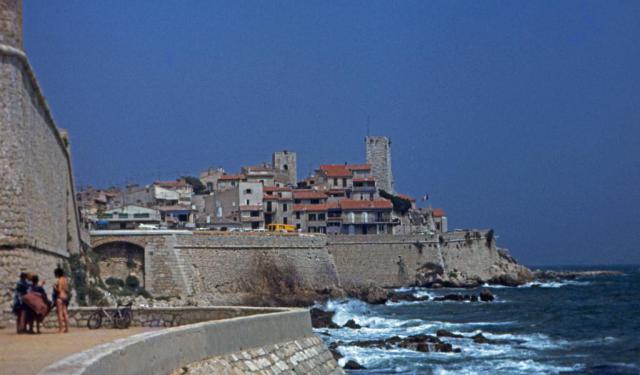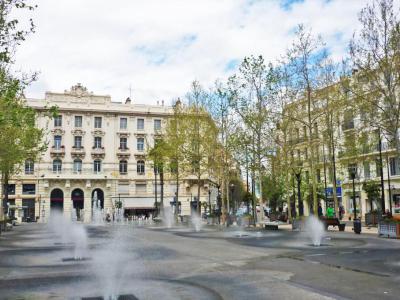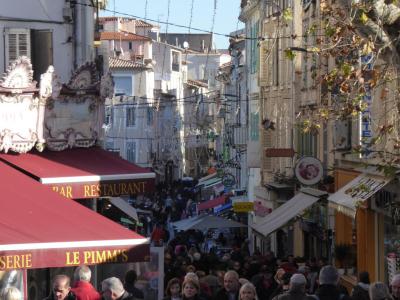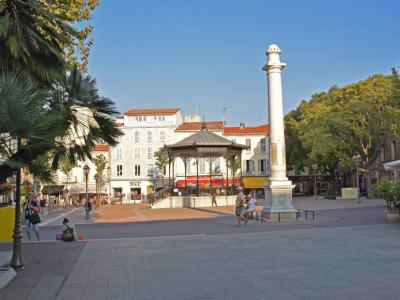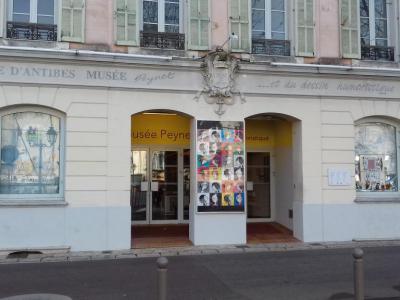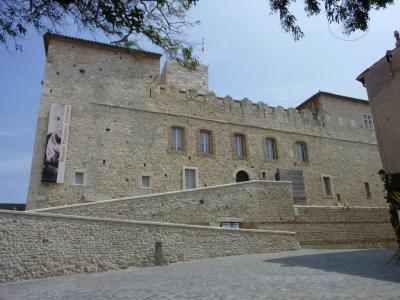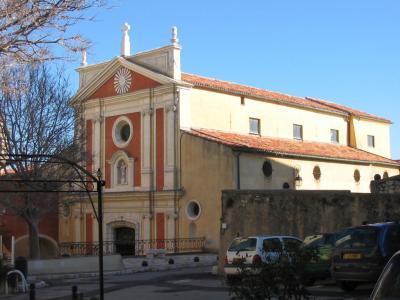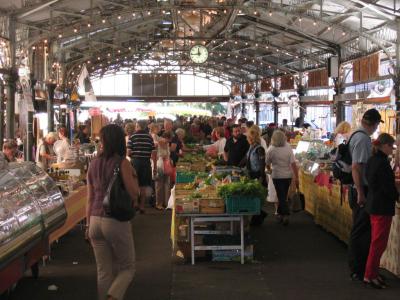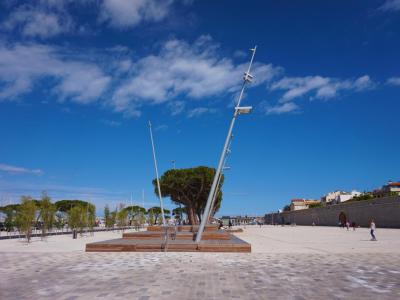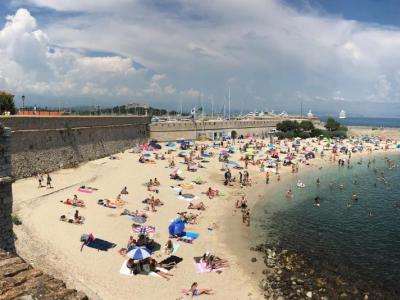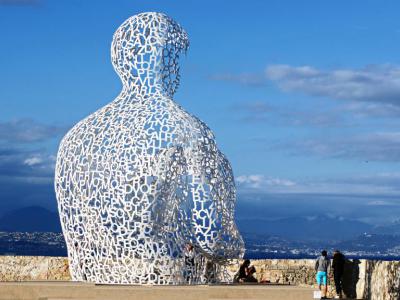Antibes Introduction Walking Tour (Self Guided), Antibes
Nestled along the impressive 25 kilometers of sun-kissed shores of the French Riviera, Antibes is the quintessential summertime getaway. Its stunning natural setting characterized by lots of sunny days, pine groves, and sandy beaches is complemented by a lively ambiance, which collectively has long been a source of inspiration for artists such as Claude Monet and Pierre-Auguste Renoir.
The origins of this coastal gem trace back to ancient times when in the 6th century BC it was founded by the Greeks as Antipolis, meaning "opposite the city", for its location across the bay from Νikaia (present-day Nice).
During the Roman Empire, it was an important point en route from Rome to Gaul and for a long time remained the only fortified stronghold on the coast between Marseille and Italy.
In the 2nd century, after an episcopal see was established, the town began to be called Antiboule, and over time – Antibes. In the Middle Ages, it belonged to Savoy, and from 1481 to France.
In the spring of 1815, Antibes was the first stop on Napoleon's route to Paris. Trying to enter the city, some of his soldiers were captured by the local garrison, at which the disgraced emperor looked as a minor incident, unworthy of attention, and moved on.
Under the Treaty of Turin (1860), the new Kingdom of Italy ceded Nice to France, and Antibes thus ceased being a border town, after the frontier moved 50 km eastward to Menton. Around the same time, the area regained popularity, as wealthy people from Europe discovered its natural environment and built luxurious homes there.
By the First World War, Antibes had been connected by rail to Nice and most of its fortifications had been demolished to make way for new residential construction. Pablo Picasso's visits in 1923 and 1946, during which he stayed at Château Grimaldi, birthed numerous artworks, leading to the establishment of the Picasso Museum in the castle, housing his legacy.
Among other highlights of Antibes's cultural heritage is the Nomade, a towering sculpture overlooking the azure waters, symbolizing the eternal wanderlust that defines the city.
Meanwhile, the Provencal Market tantalizes the senses with its vibrant array of fresh produce and local delicacies, inviting visitors to indulge in the flavors of Provence.
With its blend of history, cultural allure, and Mediterranean vistas, Antibes enchants visitors from near and far year-round. This self-guided walk is your chance to immerse yourself in the timeless beauty of this coastal paradise and create memories to last a lifetime.
The origins of this coastal gem trace back to ancient times when in the 6th century BC it was founded by the Greeks as Antipolis, meaning "opposite the city", for its location across the bay from Νikaia (present-day Nice).
During the Roman Empire, it was an important point en route from Rome to Gaul and for a long time remained the only fortified stronghold on the coast between Marseille and Italy.
In the 2nd century, after an episcopal see was established, the town began to be called Antiboule, and over time – Antibes. In the Middle Ages, it belonged to Savoy, and from 1481 to France.
In the spring of 1815, Antibes was the first stop on Napoleon's route to Paris. Trying to enter the city, some of his soldiers were captured by the local garrison, at which the disgraced emperor looked as a minor incident, unworthy of attention, and moved on.
Under the Treaty of Turin (1860), the new Kingdom of Italy ceded Nice to France, and Antibes thus ceased being a border town, after the frontier moved 50 km eastward to Menton. Around the same time, the area regained popularity, as wealthy people from Europe discovered its natural environment and built luxurious homes there.
By the First World War, Antibes had been connected by rail to Nice and most of its fortifications had been demolished to make way for new residential construction. Pablo Picasso's visits in 1923 and 1946, during which he stayed at Château Grimaldi, birthed numerous artworks, leading to the establishment of the Picasso Museum in the castle, housing his legacy.
Among other highlights of Antibes's cultural heritage is the Nomade, a towering sculpture overlooking the azure waters, symbolizing the eternal wanderlust that defines the city.
Meanwhile, the Provencal Market tantalizes the senses with its vibrant array of fresh produce and local delicacies, inviting visitors to indulge in the flavors of Provence.
With its blend of history, cultural allure, and Mediterranean vistas, Antibes enchants visitors from near and far year-round. This self-guided walk is your chance to immerse yourself in the timeless beauty of this coastal paradise and create memories to last a lifetime.
How it works: Download the app "GPSmyCity: Walks in 1K+ Cities" from Apple App Store or Google Play Store to your mobile phone or tablet. The app turns your mobile device into a personal tour guide and its built-in GPS navigation functions guide you from one tour stop to next. The app works offline, so no data plan is needed when traveling abroad.
Antibes Introduction Walking Tour Map
Guide Name: Antibes Introduction Walking Tour
Guide Location: France » Antibes (See other walking tours in Antibes)
Guide Type: Self-guided Walking Tour (Sightseeing)
# of Attractions: 10
Tour Duration: 1 Hour(s)
Travel Distance: 1.8 Km or 1.1 Miles
Author: DanaOffice
Sight(s) Featured in This Guide:
Guide Location: France » Antibes (See other walking tours in Antibes)
Guide Type: Self-guided Walking Tour (Sightseeing)
# of Attractions: 10
Tour Duration: 1 Hour(s)
Travel Distance: 1.8 Km or 1.1 Miles
Author: DanaOffice
Sight(s) Featured in This Guide:
- Place General de Gaulle (General de Gaulle Square)
- Rue de la République (Republic Street)
- Place Nationale (National Square)
- Peynet Museum of Humorous Drawing
- Musee Picasso (Picasso Museum)
- Antibes Cathedral
- Marche Provencal (Provencal Market)
- Pré-aux-Pêcheurs (Fishermen’s Meadow)
- Plage de la Gravette (Gravette Beach)
- Le Nomade (Nomade Sculpture)
1) Place General de Gaulle (General de Gaulle Square)
General de Gaulle Square serves as the vibrant centerpiece of Antibes. This bustling square derives its name from the renowned French general and statesman, Charles de Gaulle, whose statue once graced its grounds. Today, the square is adorned with a charming fountain, providing a refreshing retreat for locals and visitors alike, especially during hot summer days when children delight in splashing around its waters.
Situated in the heart of Antibes, General de Gaulle Square serves as a central hub for transportation, commerce, and leisure. It serves as a major transportation hub, with most buses traversing through Antibes making a stop at this bustling square. Additionally, the Antibes Central Train Station is conveniently located nearby, providing easy access for commuters and travelers arriving by rail.
Beyond its transportation connections, Place General de Gaulle is a focal point for shopping and leisure in Antibes. From the square, visitors can explore the city's busiest shopping streets, which radiate outwards in various directions, offering a diverse array of boutiques, cafes, and restaurants. Moreover, the square is home to the Antibes tourist information office, located on its north side, providing valuable resources and assistance for visitors looking to explore the city and its surrounding attractions. Here, tourists can obtain maps, brochures, and helpful recommendations to enhance their experience in Antibes and make the most of their stay.
Situated in the heart of Antibes, General de Gaulle Square serves as a central hub for transportation, commerce, and leisure. It serves as a major transportation hub, with most buses traversing through Antibes making a stop at this bustling square. Additionally, the Antibes Central Train Station is conveniently located nearby, providing easy access for commuters and travelers arriving by rail.
Beyond its transportation connections, Place General de Gaulle is a focal point for shopping and leisure in Antibes. From the square, visitors can explore the city's busiest shopping streets, which radiate outwards in various directions, offering a diverse array of boutiques, cafes, and restaurants. Moreover, the square is home to the Antibes tourist information office, located on its north side, providing valuable resources and assistance for visitors looking to explore the city and its surrounding attractions. Here, tourists can obtain maps, brochures, and helpful recommendations to enhance their experience in Antibes and make the most of their stay.
2) Rue de la République (Republic Street)
Republic Street is one of the main thoroughfares in Antibes, renowned for its vibrant atmosphere and diverse shopping opportunities. Stretching through the heart of the historic town center, this bustling car-free offers a delightful mix of boutiques, shops, cafes, and restaurants, making it a prime destination for locals and tourists alike.
Shopping along Republic Street is a truly immersive experience, with a wide array of establishments catering to every taste and preference. From chic fashion boutiques showcasing the latest trends in clothing, accessories, and footwear to quaint artisanal shops offering unique handmade crafts and souvenirs, there's something for everyone along this bustling avenue.
In addition to fashion, Republic Street also boasts an eclectic mix of specialty shops, including art galleries, jewelry stores, home decor boutiques, and more.
After a day of shopping, visitors can unwind and recharge at one of the charming cafes or eateries scattered along Republic Street. From cozy sidewalk bistros serving up freshly brewed coffee and pastries to elegant restaurants offering gourmet cuisine and local delicacies, there's no shortage of options to satisfy every palate.
Shopping along Republic Street is a truly immersive experience, with a wide array of establishments catering to every taste and preference. From chic fashion boutiques showcasing the latest trends in clothing, accessories, and footwear to quaint artisanal shops offering unique handmade crafts and souvenirs, there's something for everyone along this bustling avenue.
In addition to fashion, Republic Street also boasts an eclectic mix of specialty shops, including art galleries, jewelry stores, home decor boutiques, and more.
After a day of shopping, visitors can unwind and recharge at one of the charming cafes or eateries scattered along Republic Street. From cozy sidewalk bistros serving up freshly brewed coffee and pastries to elegant restaurants offering gourmet cuisine and local delicacies, there's no shortage of options to satisfy every palate.
3) Place Nationale (National Square)
National Square is one of the city's most picturesque squares, offering a glimpse into its rich history and vibrant culture. At the center of the square rises a magnificent 5-meter-high stone column, a symbol of resilience and loyalty gifted to the people of Antibes by Louis XVIII. This imposing monument serves as a testament to the city's steadfast allegiance to the French monarchy during a pivotal moment in history.
The marble column in National Square is adorned with inscriptions that commemorate significant events in Antibes' past. One inscription, dating back to May 31, 1818, marks the erection of the column, while another recounts the courageous defiance of the city's inhabitants against Napoleon's return from exile on the island of Elba in August and September 1815. Despite facing bombardments and daunting odds, the people of Antibes remained steadfast in their loyalty to Louis XVIII, earning the admiration of the monarch, who declared their conduct unforgettable.
Today, National Square serves as more than just a historic landmark; it is also a vibrant hub of activity and community gatherings. The square occasionally hosts markets where visitors can peruse a delightful array of products, including antiques, handicrafts, jewelry, and other unique items. These markets add to the lively atmosphere of the square, attracting locals and tourists alike to explore its offerings and soak in the charm of Antibes' bustling city center.
The marble column in National Square is adorned with inscriptions that commemorate significant events in Antibes' past. One inscription, dating back to May 31, 1818, marks the erection of the column, while another recounts the courageous defiance of the city's inhabitants against Napoleon's return from exile on the island of Elba in August and September 1815. Despite facing bombardments and daunting odds, the people of Antibes remained steadfast in their loyalty to Louis XVIII, earning the admiration of the monarch, who declared their conduct unforgettable.
Today, National Square serves as more than just a historic landmark; it is also a vibrant hub of activity and community gatherings. The square occasionally hosts markets where visitors can peruse a delightful array of products, including antiques, handicrafts, jewelry, and other unique items. These markets add to the lively atmosphere of the square, attracting locals and tourists alike to explore its offerings and soak in the charm of Antibes' bustling city center.
4) Peynet Museum of Humorous Drawing
The Peynet Museum of Humorous Drawing houses a rich collection of works by Raymond Peynet and other prominent press and humor cartoonists. Situated just a stone's throw from the port and opposite the bandstand, the museum celebrates the legacy of Raymond Peynet, a renowned French artist known for his iconic creation, "the Lovers."
Raymond Peynet, born on November 16, 1908, in Paris, rose to fame in the world of art and illustration in the 1930s. His distinctive artistic style quickly gained recognition, leading to collaborations with major publications and newspapers. However, it was in 1943, during a chance encounter in front of the Valence kiosk, that Peynet sketched a charming couple, affectionately dubbed "the Lovers" by the editor-in-chief of the newspaper Ric et Rac, Max Favalelli. This marked the beginning of the "Peynetmania," with the endearing duo captivating audiences worldwide for over forty years.
In 1976, Peynet chose to settle in Antibes, where he continued to enrich the cultural landscape of the city through his art. Inspired by his prolific career and contributions to the art world, the idea of establishing a museum dedicated to Peynet's work was proposed in 1988 by Pierre Merli, then-senator and mayor of Antibes. Peynet enthusiastically supported the initiative, generously donating nearly 300 works to form the museum's permanent collection.
Today, the Peynet Museum of Humorous Drawing offers visitors a captivating journey through the whimsical world of Raymond Peynet and his contemporaries. The museum's collection showcases Peynet's iconic illustrations, alongside works by other humor cartoonists, providing insight into the evolution of humorous drawing over the years. As visitors explore the museum's galleries, they are treated to a delightful array of artworks, anecdotes, and insights into the life and career of Raymond Peynet, ensuring an engaging and memorable experience for art enthusiasts and visitors alike.
Raymond Peynet, born on November 16, 1908, in Paris, rose to fame in the world of art and illustration in the 1930s. His distinctive artistic style quickly gained recognition, leading to collaborations with major publications and newspapers. However, it was in 1943, during a chance encounter in front of the Valence kiosk, that Peynet sketched a charming couple, affectionately dubbed "the Lovers" by the editor-in-chief of the newspaper Ric et Rac, Max Favalelli. This marked the beginning of the "Peynetmania," with the endearing duo captivating audiences worldwide for over forty years.
In 1976, Peynet chose to settle in Antibes, where he continued to enrich the cultural landscape of the city through his art. Inspired by his prolific career and contributions to the art world, the idea of establishing a museum dedicated to Peynet's work was proposed in 1988 by Pierre Merli, then-senator and mayor of Antibes. Peynet enthusiastically supported the initiative, generously donating nearly 300 works to form the museum's permanent collection.
Today, the Peynet Museum of Humorous Drawing offers visitors a captivating journey through the whimsical world of Raymond Peynet and his contemporaries. The museum's collection showcases Peynet's iconic illustrations, alongside works by other humor cartoonists, providing insight into the evolution of humorous drawing over the years. As visitors explore the museum's galleries, they are treated to a delightful array of artworks, anecdotes, and insights into the life and career of Raymond Peynet, ensuring an engaging and memorable experience for art enthusiasts and visitors alike.
5) Musee Picasso (Picasso Museum) (must see)
Located within the historic Château Grimaldi, the Picasso Museum offers visitors a captivating journey into the world of one of the most celebrated artists of the 20th century. Pablo Picasso himself used this medieval fortress as his art studio for several months in 1946, during which he created an impressive collection of 23 paintings and 44 drawings. Today, the museum stands as a testament to Picasso's profound influence on modern art and showcases over 200 of his works, including many iconic pieces.
As visitors wander through the museum's halls, they are immersed in Picasso's unparalleled creativity and artistic genius. The collection spans various periods of Picasso's career, offering insights into his evolving style and techniques. From vibrant paintings to intricate drawings, each artwork provides a glimpse into Picasso's boundless imagination and his ability to capture the essence of the human experience.
In addition to Picasso's works, the museum also houses a remarkable permanent collection featuring modern and contemporary artworks by renowned artists such as Nicolas de Staël, Hans Hartung, Anna-Eva Bergman, and Joan Miró. The museum's expansive terrace serves as an outdoor gallery, showcasing sculptures by prominent artists including Joan Miró, Germaine Richier, and Bernard Pagès, among others.
With its stunning sea views, historic setting, and unparalleled collection of masterpieces, the Musée Picasso in Antibes offers visitors a unique opportunity to explore the legacy of one of the greatest artists of the 20th century while also discovering other renowned talents of the modern art world.
As visitors wander through the museum's halls, they are immersed in Picasso's unparalleled creativity and artistic genius. The collection spans various periods of Picasso's career, offering insights into his evolving style and techniques. From vibrant paintings to intricate drawings, each artwork provides a glimpse into Picasso's boundless imagination and his ability to capture the essence of the human experience.
In addition to Picasso's works, the museum also houses a remarkable permanent collection featuring modern and contemporary artworks by renowned artists such as Nicolas de Staël, Hans Hartung, Anna-Eva Bergman, and Joan Miró. The museum's expansive terrace serves as an outdoor gallery, showcasing sculptures by prominent artists including Joan Miró, Germaine Richier, and Bernard Pagès, among others.
With its stunning sea views, historic setting, and unparalleled collection of masterpieces, the Musée Picasso in Antibes offers visitors a unique opportunity to explore the legacy of one of the greatest artists of the 20th century while also discovering other renowned talents of the modern art world.
6) Antibes Cathedral
Nestled at the end of a charming cobblestone street and framed by the tranquil sea, Antibes Cathedral, stands as a serene oasis in the heart of Antibes, France. Its picturesque location, beneath the majestic Chateau Grimaldi, lends an air of romance and splendor to this architectural gem. Unlike the typical stone churches found elsewhere, Antibes Cathedral boasts a soft rose-hued facade that perfectly complements the elegance of the town's old quarter.
Approaching the cathedral, visitors are greeted by a small plaza offering a perfect view of its delightful exterior. Stepping inside, one is immediately struck by the cathedral's rich history and artistic treasures. From the intricately crafted doors, a testament to the skill of 18th-century sculptor Jacques Dolle, to the breathtaking 16th-century altarpiece, the Virgin of the Rosary by Louis Bréa, the interior exudes a sense of divine beauty and reverence.
The Virgin of the Rosary altarpiece, depicting Christ as a child cradled by Mary surrounded by cherubs, is a masterpiece surrounded by panels illustrating the 15 Mysteries of the Rosary. Despite enduring centuries of attacks and subsequent rebuilding, the cathedral has retained its spiritual significance and served as the seat of the bishops of Antibes before becoming the seat of the Bishops of Grasse. Today, it stands as a testament to Antibes' rich heritage and religious devotion.
For a memorable conclusion to your visit, don't miss the opportunity to admire the breathtaking views of the French Riviera from the rear side of the cathedral.
Approaching the cathedral, visitors are greeted by a small plaza offering a perfect view of its delightful exterior. Stepping inside, one is immediately struck by the cathedral's rich history and artistic treasures. From the intricately crafted doors, a testament to the skill of 18th-century sculptor Jacques Dolle, to the breathtaking 16th-century altarpiece, the Virgin of the Rosary by Louis Bréa, the interior exudes a sense of divine beauty and reverence.
The Virgin of the Rosary altarpiece, depicting Christ as a child cradled by Mary surrounded by cherubs, is a masterpiece surrounded by panels illustrating the 15 Mysteries of the Rosary. Despite enduring centuries of attacks and subsequent rebuilding, the cathedral has retained its spiritual significance and served as the seat of the bishops of Antibes before becoming the seat of the Bishops of Grasse. Today, it stands as a testament to Antibes' rich heritage and religious devotion.
For a memorable conclusion to your visit, don't miss the opportunity to admire the breathtaking views of the French Riviera from the rear side of the cathedral.
7) Marche Provencal (Provencal Market) (must see)
Located in the heart of Antibes, the Provencal Market is a daily spectacle that delights the senses and captures the essence of regional gastronomy. From as early as 6 am, the market comes to life under the covered hall of Masséna Court, offering visitors and locals alike a vibrant display of color, flavor, and aroma. The morning scene is a lively affair, with stallholders bustling to set up their offerings, while the air fills with the murmur of eager shoppers engrossed in their daily shopping rituals.
The Provencal Market is a true celebration of regional culinary diversity, showcasing an array of delights from the Provence-Alpes-Côte d'Azur region. Visitors can explore stalls brimming with mountain cheeses, delicatessen specialties, aromatic spices, and a vibrant selection of fresh or dried flowers. From traditional Provencal herbs to locally sourced fruits and vegetables, the market offers a feast for the senses, inviting visitors to immerse themselves in the rich flavors and aromas of the Mediterranean.
As the morning rush subsides and lunchtime approaches, the market undergoes a transformation. The bustling atmosphere gives way to a more relaxed ambiance, as local restaurants surrounding the market extend their tables under the sheltered area. Here, visitors can indulge in alfresco dining, enjoying delicious Provençal cuisine amidst the lively backdrop of the market. Laughter fills the air, glasses clink in celebration, and the aroma of freshly prepared dishes adds to the sensory tapestry of the experience, creating an unforgettable culinary journey in the heart of Antibes.
The Provencal Market is a true celebration of regional culinary diversity, showcasing an array of delights from the Provence-Alpes-Côte d'Azur region. Visitors can explore stalls brimming with mountain cheeses, delicatessen specialties, aromatic spices, and a vibrant selection of fresh or dried flowers. From traditional Provencal herbs to locally sourced fruits and vegetables, the market offers a feast for the senses, inviting visitors to immerse themselves in the rich flavors and aromas of the Mediterranean.
As the morning rush subsides and lunchtime approaches, the market undergoes a transformation. The bustling atmosphere gives way to a more relaxed ambiance, as local restaurants surrounding the market extend their tables under the sheltered area. Here, visitors can indulge in alfresco dining, enjoying delicious Provençal cuisine amidst the lively backdrop of the market. Laughter fills the air, glasses clink in celebration, and the aroma of freshly prepared dishes adds to the sensory tapestry of the experience, creating an unforgettable culinary journey in the heart of Antibes.
8) Pré-aux-Pêcheurs (Fishermen’s Meadow)
The Fishermen's Meadow is a charming public space nestled in the heart of Antibes, renowned for its picturesque setting and vibrant atmosphere. Situated along the waterfront, this idyllic meadow offers visitors a tranquil retreat where they can relax and soak in the scenic beauty of the Mediterranean coast.
One of the highlights of Fishermen's Meadow is the iconic Ferris wheel that graces its skyline, adding a touch of whimsy and enchantment to the surroundings. Rising majestically above the meadow, the Ferris wheel offers panoramic views of Antibes and its stunning coastline, providing visitors with a unique vantage point to admire the azure waters and historic landmarks that dot the landscape.
As visitors take a leisurely stroll throughFishermen's Meadow, they'll discover lush greenery, blooming flowers, and shaded seating areas, creating an inviting ambiance for picnics, leisurely walks, and peaceful moments of reflection. The gentle sea breeze and the sound of lapping waves further enhance the tranquil atmosphere, making it a favorite spot for both locals and tourists alike.
Throughout the year, Fishermen's Meadow hosts various events and activities, ranging from cultural festivals to artisan markets, adding to the vibrant energy of the meadow.
One of the highlights of Fishermen's Meadow is the iconic Ferris wheel that graces its skyline, adding a touch of whimsy and enchantment to the surroundings. Rising majestically above the meadow, the Ferris wheel offers panoramic views of Antibes and its stunning coastline, providing visitors with a unique vantage point to admire the azure waters and historic landmarks that dot the landscape.
As visitors take a leisurely stroll throughFishermen's Meadow, they'll discover lush greenery, blooming flowers, and shaded seating areas, creating an inviting ambiance for picnics, leisurely walks, and peaceful moments of reflection. The gentle sea breeze and the sound of lapping waves further enhance the tranquil atmosphere, making it a favorite spot for both locals and tourists alike.
Throughout the year, Fishermen's Meadow hosts various events and activities, ranging from cultural festivals to artisan markets, adding to the vibrant energy of the meadow.
9) Plage de la Gravette (Gravette Beach)
Gravette Beach, nestled discreetly behind the historic ramparts at the end of the port in Antibes, is widely regarded as one of the most enchanting public beaches in the area. Its allure lies in its fine, white gravel shores and translucent waters, which exude a sense of tranquility and natural beauty. This idyllic beach is a favorite among locals, drawing a loyal crowd who appreciates its serene atmosphere and stunning surroundings.
For residents and visitors staying in Old Antibes, Gravette Beach holds particular appeal as it is the closest beach, offering a convenient spot for a refreshing dip after a morning of exploring the town's bustling market. The sheltered cove boasts shallow waters and is protected by a rocky breakwater, ensuring a safe and enjoyable swimming experience for families with children. However, swimmers should be cautious of the rocks just beneath the surface, which may pose a hazard to those seeking deeper waters.
Gravette Beach is equipped with beach showers and lifeguards during the peak season in July and August, providing added peace of mind for beachgoers. Despite past concerns regarding water quality, significant improvements have been made in recent years, making it a safer and more inviting destination for swimming and relaxation. With its picturesque setting and improved amenities, Gravette Beach offers a delightful retreat for those seeking a tranquil escape along the scenic coastline of Antibes.
For residents and visitors staying in Old Antibes, Gravette Beach holds particular appeal as it is the closest beach, offering a convenient spot for a refreshing dip after a morning of exploring the town's bustling market. The sheltered cove boasts shallow waters and is protected by a rocky breakwater, ensuring a safe and enjoyable swimming experience for families with children. However, swimmers should be cautious of the rocks just beneath the surface, which may pose a hazard to those seeking deeper waters.
Gravette Beach is equipped with beach showers and lifeguards during the peak season in July and August, providing added peace of mind for beachgoers. Despite past concerns regarding water quality, significant improvements have been made in recent years, making it a safer and more inviting destination for swimming and relaxation. With its picturesque setting and improved amenities, Gravette Beach offers a delightful retreat for those seeking a tranquil escape along the scenic coastline of Antibes.
10) Le Nomade (Nomade Sculpture) (must see)
The Nomade Sculpture, stands as one of the most captivating landmarks in Antibes, gracing the area outside the Bastion Saint-Jaume with its imposing presence. Crafted by the renowned artist Jaume Plensa, this monumental white sculpture has become a symbol of the French Riviera's artistic allure.
The sculpture itself is a striking depiction of a seated figure, fashioned from ironwork, gazing serenely out towards the sea. Its massive yet graceful form invites contemplation and reflection, adding a sense of tranquility to the bustling surroundings. Positioned against the backdrop of the picturesque coastline, The Nomade offers visitors an opportunity to immerse themselves in both art and nature simultaneously.
The location of The Nomade holds significance beyond its artistic appeal. Bastion Saint-Jaume, where the sculpture resides, has a rich history dating back to the Roman occupation of the region. Over the centuries, the site has been home to a chapel, a temple, and later a tower, before eventually becoming the Bastion Shipyard. Despite its storied past, the area underwent transformation, with the shipyard closing its doors in the 1980s.
The sculpture itself is a striking depiction of a seated figure, fashioned from ironwork, gazing serenely out towards the sea. Its massive yet graceful form invites contemplation and reflection, adding a sense of tranquility to the bustling surroundings. Positioned against the backdrop of the picturesque coastline, The Nomade offers visitors an opportunity to immerse themselves in both art and nature simultaneously.
The location of The Nomade holds significance beyond its artistic appeal. Bastion Saint-Jaume, where the sculpture resides, has a rich history dating back to the Roman occupation of the region. Over the centuries, the site has been home to a chapel, a temple, and later a tower, before eventually becoming the Bastion Shipyard. Despite its storied past, the area underwent transformation, with the shipyard closing its doors in the 1980s.
The Most Popular Cities
/ view all
